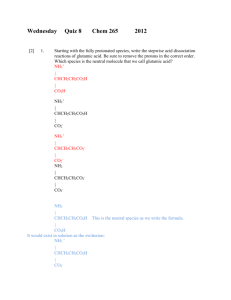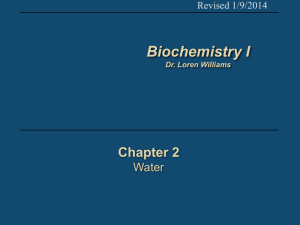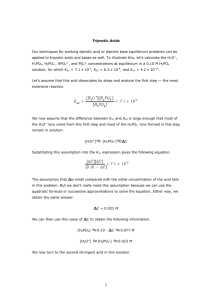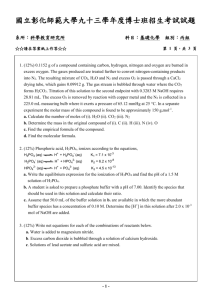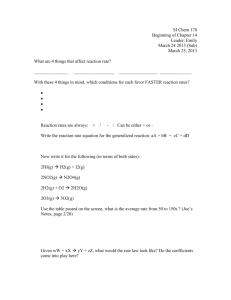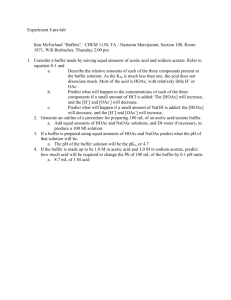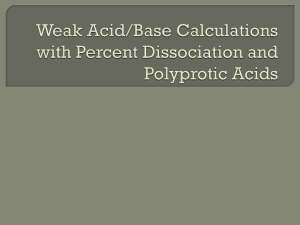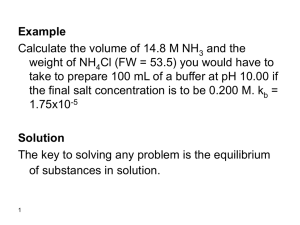Acid Base Equilibria
advertisement
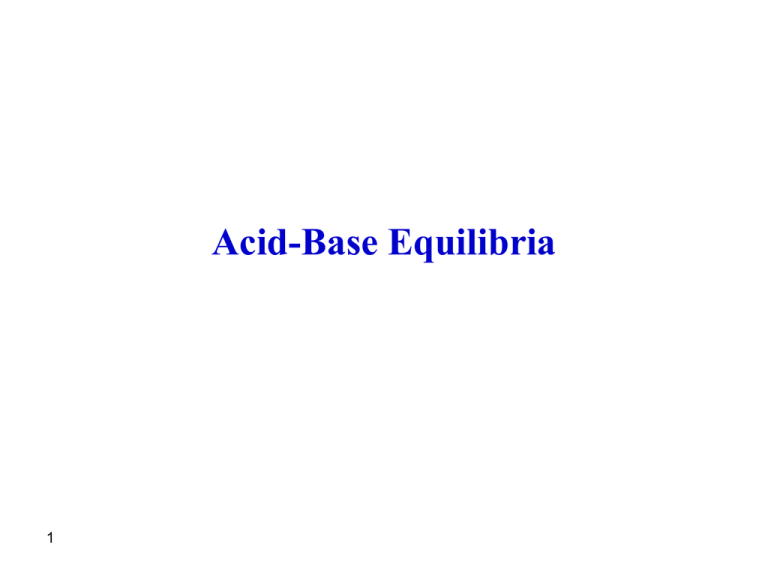
Acid-Base Equilibria
1
In
2
this chapter, we study equilibrium
problems as related to acids and bases as
well as their salts. The main point is to
know how to calculate the hydrogen ion
concentration, [H+]. However, let us start
with definitions of acids and bases and
then look at their equilibria.
Acid-Base Theories
Four main attempts to define acids and
bases are common in the literature of
chemistry. Development of these
attempts or theories usually followed a
desire to explain the behavior of
substances and account for their
properties as related to having acidic or
basic characteristics. Theories of
acidity or basicity can be outlined
below from oldest to most recent:
3
1. Arrhenius theory: This theory is limited
to water as a solvent where an acid is
defined as a substance which ionizes in
water and donates a proton. A base is a
substance that ionizes in water to give
hydroxide ions. The hydrogen ion reacts
with water to give a hydronium ion while
the base reacts with water to yield a
hydroxide ion.
HA + H2O D H3O+ + AB + H2O D BH+ + OH4
2. Franklin Theory: This theory introduced
the solvent concept where an acid was
defined as a substance that reacts with
the solvent to produce the cation of the
solvent . The base is a substance that
reacts with the solvent to yield the
anion of the solvent.
HA + EtOH D EtOH2+ + AB + EtOH D BH+ + EtO5
3. Bronsted-Lowry Theory: Some solvents like
hexane or benzene are non ionizable and the
Franklin theory can not be used to explain acidic
or basic properties of substances. In BronstedLowry theory, an acid is defined as a
substance that can donate a proton while a
base is a substance that can accept a proton.
Also, an acid is composed of two components; a
proton and a conjugate base. For example
HOAc D H+ + OAcAcetic acid is an acid which donates a proton and
its proton is associated with a base that can
accept the proton; this base is the acetate.
6
4. Lewis Theory: Lewis introduced the electronic
theory for acids and bases where in Lewis
theory an acid is defined as a substance that
accepts electrons while a base is a
substance that donates electrons. Therefore,
ammonia is a base because it donates electrons
as in the reaction
H+ + :NH3 D H:NH3+
AlCl3 is an acid because it accepts electrons from
a base such as :OR2
AlCl3 + : OR2 = Cl3Al:OR2
7
Lecture 21
Acid-Base Equilibria, Cont….
Strong Acids/Bases and Their Salts
8
Acid-Base Equilibria in Water
Fortunately, we will only deal with aqueous
solutions which means that water will always be
our solvent. Water itself undergoes self
ionization as follows
2 H2O D H3O+ + OHK = [H3O+][OH-]/[H2O]2
However, only a very small amount of water does
ionize and the overall water concentration will be
constant.
9
Therefore, one can write
Kw = [H3O+][OH-]
Kw is called autoprotolysis constant of water
or ion product of water, we will also refer
to [H3O+] as simply [H+] although this is not
strictly correct due to the very reactive
nature of H+
Kw = [H+][OH-] = 10-14 at 25 oC.
10
The pH Scale
In most cases, the hydrogen ion concentration is
very small which makes it difficult to practically
express a meaningful concept for such a small
value. Currently, the pH scale is used to better
have an appreciation of the value of the
hydrogen ion concentration where:
pH = - log [H+]
We also know that kw = [H+][OH-] = 10-14 or
pH + pOH = 14
Therefore, calculation of either pH or pOH can be
used to find the other.
11
We are faced with different types of solutions that we
should know how to calculate the pH or pOH for. These
include calculation of pH for
1. Strong acids and strong bases
2. Weak acids (monoprotic) and weak bases
(monobasic)
3. Salts of weak acids and salts of weak bases
4. Mixtures of weak acids and their salts (buffer
solutions)
5. Polyprotic acids and their salts and polybasic bases
and their salts
We shall also look at pH calculations for mixtures of
acids and bases as well as pH calculations for very
dilute solutions of the abovementioned systems.
12
pH calculations
1. Strong Acids and Strong Bases
Strong acids and strong bases are those
substances which are completely
dissociated in water and dissociation is
represented by one arrow pointing to
right. Examples of strong acids include
HCl, HBr, HI, HNO3, HClO4, and H2SO4
(only first proton). Examples of strong
bases include NaOH, KOH, Ca(OH)2, as
well as other metal hydroxides.
13
Find the pH of a 0.1 M HCl solution.
HCl is a strong acid that completely
dissociates in water, therefore we have
HCl H+ + ClH2O D H+ + OH[H+]Solution = [H+]from HCl + [H+]from water
However, [H+]from water = 10-7 in absence of a
common ion, therefore it will be much less in
presence of HCl and can thus be neglected
as compared to 0.1 ( 0.1>>[H+]from water)
[H+]solution = [H+]HCl = 0.1M
pH = -log 0.1 = 1
14
We can always look at the equilibria present
in water to solve such questions, we have
only water that we can write an equilibrium
constant for and we can write:
15
Kw = (0.1 + x)(x)
However, x is very small as compared to 0.1
(0.1>>x)
10-14 = 0.1 x
x = 10-13 M
Therefore, the [OH-] = 10-13 M = [H+]from water
Relative error = (10-13/0.1) x 100 = 10-10%
[H+] = 0.1 + x = 0.1 + 10-13 ~ 0.1 M
pH = 1
16
Find the pH of a 1x10-5 M HNO3 solution.
Nitric acid is a strong acid which means that it
dissociates completely in water. Therefore,
[H+]from Nitric acid = 1x10-5 M
We can now set the equilibria in water as
above
17
Kw = (10-5 + x)(x)
However, x is very small as compared to 10-5 (10-5>>x)
10-14 = 10-5 x
x = 10-9 M
Therefore, the [OH-] = 10-9 M = [H+]from water
Relative error = (10-9/10-5) x 100 = 0.01 %
[H+] = 10-5 + 10-9 ~ 10-5 M
pH = - log 10-5 = 5
18
Find the pH of a 10-7 M HCl solution.
Solution
HCl is a strong acid, therefore the [H+]from HCl =10-7 M
19
Kw = (10-7 + x)(x)
Let us assume that x is very small as compared to 10-7
(10-7>>x)
10-14 = 10-7 x
x = 10-7 M
Therefore, the [OH-] = 10-7 M = [H+]from water
Relative error = (10-7/10-7) x 100 = 100 %
Therefore, the assumption is invalid and we have to
solve the quadratic equation. Solving the quadratic
equation gives:
[H+] = 7.62x10-7 M
pH = 6.79
20
Find the pH of a 10-10 M HCl solution.
HCl H+ + ClH2O D H+ + OH[H+]Solution = [H+]from HCl + [H+]from water
Before equil
Equation
After equil
21
H2O
10-10
H+
10-10 + x
0
OHx
Assume 10-10>>x
X = 10-4 , it is clear that the assumption is
invalid. In fact x is much larger than 10-10.
Therefore reverse assumption and
assume x>>10-4
10-14 = (10-10 + x)(x)
X = 10-7
RE = (10-7/10-10)*100% = 0.1%
The assumption is valid and [H+] = [OH-]
= 10-7 M
pH = 7
22
Calculate the pH of the solution resulting from
mixing 50 mL of 0.1 M HCl with 50 mL of 0.2 M
NaOH.
When HCl is mixed with NaOH neutralization takes
place where they react in a 1:1 mole ratio.
Therefore, find mmol of each reagent to see if
there is an excess of either reagent
mmol HCl = 0.1 x 50 = 5 mmol
mmol NaOH = 0.2 x 50 = 10 mmol
mmol NaOH excess = 10 – 5 = 5 mmol
[OH-] = 5/100 = 0.05 M
23
Find [H+] which is equal to [OH-]water
[H+] = 10-14/0.05 = 2*10-13M
[OH-]water = 2*10-13M
The hydroxide ion concentration from the
base is high enough to neglect the
contribution from water.
pOH = 1.3 and pH = 14 – pOH = 14 – 1.3 =
12.7
24
It is better to use the equilibrium
Before equil
Equation
H2O
0
0.05
H+
OH-
x
0.05 + x
After equil
10-14 = (0.05 + x)(x)
Assume 0.05>>x
X= 2*10-13, RE = very small
[OH-] = 0.05 M, and pOH = 1.3
pH = 14 – 1.3 = 12.7
25
Find the pH of a solution prepared by mixing 2.0 mL of
a strong acid at pH 3.0 and 3.0 mL of a strong base
at pH 10.
Solution
First, find the concentration of the acid and the base
pH = 3.0 means [H+] = 10-3.0
pH = 10 means [H+] = 10-10 M or [OH-] = 10-4 M
Now find the number of mmol of each
mmol H+ = 10-3 x 2.0 = 2.0x10-3 mmol
mmol OH- = 10-4 x 3.0 = 3.0 x 10-4 mmol
mmol H+ excess = 2.0x10-3 – 3.0x10-4 = 1.7x10-3
[H+] = 1.7x10-3/5 = 3.4x10-4 M
pH = - log 3.4x10-4 = 3.5
26
2. Salts of Strong Acids and Bases
The pH of the solution of salts of strong
acids or bases will remain constant (pH
= 7) where the following arguments
apply:
NaCl dissolves in water to give Cl- and
Na+. For the pH to change, either or
both ions should react with water.
However, is it possible for these ions to
react with water? Let us see:
27
Cl- + H2O D HCl + OH- (wrong equation)
Now, the question is whether it is
possible for HCl to form as a product in
water!! Of course this will not happen
as HCl is a strong acid which is 100%
dissociated in water. Therefore, Cl- will
not react with water but will stay in
solution as a spectator ion. The same
applies for any metal ion like K+ where
if we assume that it reacts with water
we will get:
28
K+ + H2O D KOH + H+ (wrong equation)
Now, the question is whether it is possible for
KOH to form as a product in water!! Of
course this will not happen as KOH is a
strong base which is 100% dissociated in
water. Therefore, K+ will not react with water
but will stay in solution as a spectator ion. It
is clear now that neither K+ nor Cl- react with
water and the hydrogen ion concentration of
solutions of salts of strong acids and bases
comes from water dissociation only and will
be 10-7 M (pH =7).
29
Lecture 22
Acid-Base Equilibria, Cont…
Weak acids/Bases and their Salts
30
3. Weak Acids and Bases
A weak acid or base is an acid or base that
partially (less than 100%) dissociated in
water. The equilibrium constant is usually
small and, in most cases, one can use the
concepts mentioned in the equilibrium
calculations section discussed previously
with application of the assumption that the
amount dissociated is negligible as
compared to original concentration. This
assumption is valid if the equilibrium
constant is very small and the concentration
of the acid or base is high enough.
31
Calculate the pH and pOH for a 0.10 M acetic acid
solution. Ka= 1.75x10-5
Solution
[H+]solution = [H+]HOAc + [H+]water
However, in absence of an acid the dissociation of
water is extremely small and in presence of an acid
dissociation of water becomes negligible due to the
common ion effect. Therefore, we can neglect the
[H+]water (which is equal to [OH-]) in presence of an
acid since the hydroxide ion concentration is
insignificant in an acid solution, therefore we can
write
32
[H+]solution = [H+]HOAc
The first point is to write the equilibrium where
HOAc D H+ + OAc-
33
Ka = [H+][OAc-]/[HOAc]
Ka = x * x / (0.10 – x)
Ka is very small. Assume 0.10 >> x
1.75*10-5 = x2/0.10
x = 1.3x10-3
Relative error = (1.3x10-3/0.10) x 100 = 1.3%
The assumption is valid and the [H+] = 1.3x10-3 M
pH = 2.88
pOH = 14 – 2.88 = 11.12
Now look at the value of [OH-] = 10-11.12 M = 7.6x10-12 M =
[H+]from water.
Therefore, the amount of H+ from water is negligible
34
Calculate the pH and pOH for a 1.00x10-3 M acetic acid
solution. Ka = 1.75x10-5
Solution
The first point is to write the equilibrium where
HOAc D H+ + OAc-
35
Ka = [H+][OAc-]/[HOAc]
Ka = x * x / (1.00*10-3 – x)
Ka is very small. Assume 1.00*10-3 >> x
1.75*10-5 = x2/1.00*10-3
x = 1.32x10-4
Relative error = (1.32x10-4/1.00x10-3) x 100 =
13.2%
The relative error is more than 5% therefore,
the assumption is invalid and we have to use
the quadratic equation to solve the problem.
36
Find the pH and pOH of a 0.20 M ammonia
solution. Kb = 1.8x10-5.
Solution
The same treatment above can be used to
solve this problem where:
[OH-]solution = [OH-]ammonia + [OH-]water
[H+] = [OH-]water
However, in absence of a base the dissociation
of water is extremely small and in presence
of the base the dissociation of water
becomes negligible due to the common ion
37 effect.
Therefore, we can neglect the [H+] in presence
of ammonia since the hydrogen ion
concentration is insignificant in basic
solution, therefore we can write
OH-]solution = [OH-]ammonia
NH3 + H2O D NH4+ + OH-
38
Kb = [NH4+][OH-]/[NH3]
1.8*10-5 = x * x / (0.20 – x)
kb is very small that we can assume that
0.20>>x. We then have:
1.8*10-5 = x2 / 0.2
x = 1.9x10-3 M
Relative error = (1.9x10-3 /0.2) x 100 = 0.95%
The assumption is valid, therefore:
[OH-] = 1.9x10-3 M, [H+] = 5.3x10-12 M = [OH-]water
which is very small.
pOH = 2.72
pH = 11.28
39
4. Salts of Weak Acids and Bases
a. Salts derived from weak acids/bases and strong
bases/acids
Imagine that an acid is formed from two species a
hydrogen ion and a conjugate base attached to it.
The acid is said to be strong if its conjugate base is
weak while a weak acid has a strong conjugate base.
Therefore, we can fairly recognize conjugate bases
like Cl-, NO3-, and ClO4- as weak bases that do not
react with water and thus will not change the pH of
water (pH = 7). On the other hand, conjugate bases
derived from weak acids are strong bases which
react with water and alter its pH.
40
Examples of strong conjugate bases include
OAc-, NO2-, CN-, etc.. The same applies for
bases where weak bases are weak because
their conjugate acids are strong which means
they react with water and thus alter its pH.
One important piece of information with regards
to salts of weak acids and bases is that we
have to find their ka or kb as the equilibrium
constants given in problems are for the parent
acid or base. Let us look at the following
argument for acetic acid:
HOAc D H+ + OAcKa = [H+][OAc-]/[HOAc]
41
For the conjugate base of acetic acid (acetate)
we have
OAc- + H2O D HOAc + OHKb = [HOAc][OH-]/[OAc-]
Let us multiply ka times kb we get
Ka kb = [H+][OH-] = kw , or
Ka kb = kw
Therefore, if we know the ka for the acid we can
get the equilibrium constant for its conjugate
base since we know kw. We can find ka for
the conjugate acid by the knowledge of the
equilibrium constant of the parent base.
42
Find the pH of a 0.10 M solution of sodium
acetate. Ka = 1.75x10-5
Solution
[OH-]solution = [OH-]acetate + [OH-]water
[OH-]water = [H+]
Since the hydrogen ion concentration is very
small in a solution of a base, we can neglect
[OH-]water and we then have
[OH-]solution = [OH-]acetate
43
OAc- + H2O D HOAc + OH-
Kb = kw/ka
Kb = 10-14/1.75x10-5 = 5.7x10-10
44
Kb = [HOAc][OH-]/[OAc-]
Kb = x * x/(0.10 – x)
Kb is very small and we can fairly assume that
0.10>>x
5.7x10-10 = x2/0.1
x = 7.6 x 10-6
Relative error = (7.6x10-6/0.10) x100 = 7.6x10-3%
The assumption is valid.
[OH-] = 7.6x10-6 M
[H+] = 1.3x10-9 M = [OH-]water
45
The relative error in neglecting OH- from water
= (1.3x10-9/7.6x10-6) x 100 = 0.017%
This validate our assumption at the beginning
of the solution that [OH-]acetate >> [OH-]water
pOH = 5.12
pH = 14 – 5.12 = 8.88
46
Calculate the pH of a 0.25 M ammonium
chloride solution. Kb = 1.75x10-5
Solution
[H+]solution = [H+]ammonium + [H+]water
However, in absence of an acid the
dissociation of water is extremely small and
in presence of an acid dissociation of water
becomes negligible due to the common ion
effect. Therefore, we can neglect the [H+]water
in presence of an acid since the hydroxide
ion concentration is insignificant in an acid
solution
47
therefore we can write
[H+]solution = [H+]ammonium
The first point is to write the equilibrium where
NH4+ D H+ + NH3
48
Ka = 10-14/1.75x10-5 = 5.7x10-10
Ka = [H+][NH3]/[NH4+]
Ka = x * x / (0.25 – x)
Ka is very small. Assume 0.25 >> x
5.7*10-10 = x2/0.25
x = 1.2x10-5
Relative error = (1.2x10-5/0.25) x 100 = 4.8x10-3 %
The assumption is valid and the [H+] = 1.2x10-5 M
49
Now look at the value of [OH-] = 10-14/1.2x10-5 =
8.3x10-10 M = [H+]from water.
Therefore, the amount of H+ from water is
negligible when compared to that from the
acid.
The relative error for neglecting the H+ from
water = (8.3x10-10/1.2x10-5) x 100 = 6.9x10-3%
pH = 4.92
pOH = 14 – 4.92 = 9.08
We should remember that dissociation of water
is negligible in presence of an acid or base.
50
b. Salts derived from weak acids/bases
and weak bases/acids
In this case, both ions are strong
conjugates that react with water and
may affect the pH of the solution.
For example, look at the calculation of pH
for a 0.1 M NH4CN (kb, NH3 = 1.8*10-5, ka,
-10)
=
6*10
HCN
51
NH4+ D H+ + NH3
ka = 5.7*10-10
CN- + H2O D HCN + OH- kb = 1.7*10-5
Comparing the equilibrium constants suggests
that the lower one is much larger than the
first. This suggests that:
1. The first equilibrium can be neglected.
2. The solution will be basic.
Since the solution is basic, water dissociation
can be assumed to be neglected as well,
due to common ion effect.
52
It is therefore justified to assume that the only
important equilibrium is:
CN- + H2O D HCN + OH- kb = 1.7*10-5
Before equil
Equation
After equil
0
0
CN- + H2O
HCN
OH-
0.1 - x
x
x
Kb = [HCN][OH-]/[CN-]
53
1.7*10-5 = x * x / (0.10 – x)
kb is very small that we can assume that
0.10>>x. We then have:
1.8*10-5 = x2 / 0.1
x = 1.3x10-3 M
Relative error = (1.3x10-3 /0.1) x 100 = 1.3%
The assumption is valid, therefore:
[OH-] = 1.3x10-3 M
pOH = 2.89
pH = 11.11
54
Lecture 23
Acid-Base Equilibria, Cont…
Buffer Solutions
55
Buffer Solutions
A buffer is a solution that resists changes in
pH upon addition of small quantities of acids
or bases. In other words, a buffer is a
solution that keeps its pH almost constant. A
buffer is a solution containing a weak acid
and its conjugate base or a weak base and
its conjugate acid. Below is an explanation of
how buffers work:
Let us look at a buffer formed from a weak acid
(like acetic acid) and its conjugate base (e.g.
sodium acetate); we have the following
equilibria:
56
HOAc D H+ + OAcOAc- + H2O D HOAc + OHIn the first equilibrium, acetate is produced from the
dissociation of acetic acid. However, there is a lot of
acetate added to solution from the sodium acetate.
Therefore, the first equilibrium does not occur to any
significant degree. We can fairly assume that HOAc
will practically not dissociate. The same applies for
the second equilibrium where acetic acid is
produced. Since a great excess of acetic acid is
present in solution from the first equilibrium, one
can say that acetate will not practically associate in
water.
57
Therefore, neither acetic acid nor acetate
equilibria will proceed to any significant
extent. The equilibrium constant for
dissociation of acetic acid can be written as:
Ka = [OAc-][H+]/[HOAc]
Where the [OAc-] = COAc- and [HOAc] = CHOAc
When an acid is added to the buffer above, H+
from the acid will combine with OAc- to form
HOAc which is reflected by an increase in
HOAc and a decrease in OAc-.
58
In case the amount of H+ added is not
very large, the ratio [OAc-]/[HOAc] will
only change slightly. A similar
argument can be presented when a
small amount of base is added to the
buffer solution. However, we will treat
the buffer problem as we described for
the common ion effect
59
Buffer Capacity
The degree of buffer resistance to changes in
pH is referred to as buffer capacity. The
buffer capacity is defined as the
concentration of acid or base ( in moles )
needed to cause a pH change equal to dpH
where:
b = dCbase/dpH = - dCacid/dpH
The minus sign is because addition of an acid
causes a decrease in pH. A more practical
relation to use for calculation of buffer
capacity is:
b = 2.303 Cacid Cconjugate base / (Cacid + Cconjugate base)
60
Calculate the buffer capacity of a solution
containing 0.10 M acetic acid and 0.10 M acetate.
Find the pH change when you add NaOH so that
the solution becomes 0.005 M in NaOH
Solution
b = 2.303 Cacid Cconjugate base / (Cacid + Cconjugate base)
b = 2.303 * 0.10 * 0.10/( 0.10 + 0.10) = 0.115 M
b = dCbase/dpH
0.115 = 0.005/dpH
dpH = 0.005/0.115 = 0.043
61
Hasselbalch-Henderson Equation
In the acetic acid/acetate buffer described
above, we have:
Ka = [OAc-][H+]/[HOAc]
Pka = pH – log [OAc-]/[HOAc]
pH = pka + log [OAc-]/[HOAc]
The above equation is referred to as
Hasselbalch-Henderson equation.
62
This equation can be useful to describe buffer
limits where the maximum pH limit for a
buffer is when the salt to acid ratio is 10 and
the minimum pH limit of the buffer is when
the acid to salt ratio is 10. Inserting these
values, one in a time, in the Hasselbalch
equation gives
pH = pka + 1
Therefore, the buffer acts well within two pH
units and the midpoint pH value is equal to
pka. One should first look at the pka or pkb to
choose the correct buffer system which can
be used within a specific pH range.
63
64
Calculate the pH of the buffer containing 0.50 M formic
acid (HA, ka = 1.8x10-4) and 0.25 M sodium formate
(NaA).
Solution
First, write the acid equilibrium equation
HA D H+ + A-
65
Ka = x (0.25 + x)/(0.50 – x)
Assume that 0.25 >> x
1.8x10-4 = 0.25 x /0.50
x = 3.6x10-4
Relative error = (3.6x10-4/0.25) x 100 = 0.14%
The assumption is therefore valid and we have
[H+] = 3.6x10-4 M
pH = 3.44
66
One can simply work the problem without
using x, since the solution is a buffer:
Ka = x * 0.25/0.50
x = 3.6x10-4
[H+] = 3.6x10-4 M
pH = 3.44
67
Calculate the pH of the buffer solution
prepared by mixing 10 mL 0.10 M HOAc (ka =
1.75x10-5) with 20 mL of 0.20 M sodium
acetate.
Solution
Let us first calculate the concentrations after
mixing (final concentrations of the acid and
its conjugate base)
mmol HOAc = 0.10 x 10 = 1.0 mmol
[HOAc] = 1.0/30
mmol OAc- = 0.20 x 20 = 4.0 mmol
68
[OAc-] = 4.0/30
The equilibrium equation is
HOAc D H+ + OAc-
69
Ka = x (4.0/30 + x)/ (1.0/30 – x)
Assume 1.0/30 >> x
1.75x10-5 = x (4.0/30)/1.0/30
x = 1.75x10-5 /4.0
x = 4.38x10-6
Relative error = {4.38x10-6/(1.0/30)} x 100 =
0.013%
The assumption is valid therefore:
[H+] = 4.38x10-6 M
pH = 5.36
70
Calculate the pH of the solution resulting from
adding 25 mL of 0.10 M NaOH to 30 mL of
0.20 M acetic acid.
Solution
Let us find what happens when we mix the two
solutions. Definitely the hydroxide will react
with the acid to form acetate which also
results in a decrease in the acid
concentration.
mmol OH- = 0.10 x 25 = 2.5 mmol
mmol HOAc = 0.20 x 30 = 6.0 mmol
71
Now the mmol base added will react in a 1:1 mole
ratio with the acid . Therefore we have
mmol HOAc left = 6.0 – 2.5 = 3.5 mmol
[HOAc] = 3.5/55 M
mmol OAc- formed = 2.5 mmol
[OAc-] = 2.5/55 M
72
Ka = x (2.5/55 + x)/ (3.5/55 – x)
Assume 2.5/55 >> x
1.75x10-5 = x (2.5/55)/3.5/55
x = 1.75x10-5 x 2.5/3.5
x = 2.45x10-5
Relative error = {2.45x10-5/(2.5/55)} x 100 =
0.054%
The assumption is valid
pH = 4.61
73
A buffer solution is 0.20 M in HOAc and in
NaOAc. Find the change in pH after addition
of 0.10 mmol of HCl to 10 mL of the buffer
without change in volume.
Solution
We should find the initial pH (before addition of
HCl) and then calculate the pH after addition.
HOAc D H+ + OAc-
74
Initial pH
Ka = x (0.20 + x)/ (0.20 – x)
Assume 0.20 >> x
1.75x10-5 = 0.20 x/ 0.20
x = 1.75x10-5
Relative error = (1.75x10-5/0.20) x 100 = 8.8x10-3%
[H+] = 1.75x10-5 M
pH = 4.76
75
After addition of HCl, the acetate concentration will
decrease while the acetic acid concentration will
increase.
mmol HOAc = 0.20 x 10 + 0.10 = 2.1 mmol
[HOAc] = 2.1/10 = 0.21 M
mmol OAc- left = 0.20 x 10 – 0.10 = 1.9 mmol
[OAc-] = 1.9/10 = 0.19 M
76
Ka = x (0.19 + x)/ (0.21 – x)
Assume 0.19 >> x
1.75x10-5 = 0.19 x/ 0.21
x = 1.93x10-5
Relative error = (1.93x10-5/0.19) x 100 = 0.01%
77
[H+] = 1.93x10-5 M
pH = 4.71
DpH = 4.71 – 4.76 = - 0.05
Try the same problem replacing NaOH for
the HCl and get the change in pH using
the same procedure. You should realize
that in this case the acetic acid will
decrease while acetate will increase.
78
Lecture 24
Acid-Base Equilibria, Cont…
Polyprotic Acids
79
Calculate the volume of 14.8 M NH3 and the
weight of NH4Cl (FW = 53.5) you would have
to take to prepare 100 mL of a buffer at pH
10.00 if the final salt concentration is to be
0.200 M. kb = 1.75x10-5
Solution
The key to solving any problem is the equilibrium
of substances in solution.
80
Here, we have ammonia and ammonium which are
combined in the equation:
NH3 + H2O D NH4+ + OHKb = [NH4+][OH-]/[NH3]
We are aware of the pH which means that we can find
[OH-] and we are given the concentration of NH4+ as
0.200 M. Therefore:
pOH = 14 – 10 = 4
[OH-] = 10-4 M
Now we can solve the equilibrium relation to find [NH3]
1.75x10-5 = (0.200x 10-4)/[NH3]
[NH3] = 1.14 M
81
We need 100 mL of 1.14 M to be prepared from 14.8 M
so we have
mmol ammonia needed = 1.14x100 = 114 mmol
mL ammonia = mmol/molarity = 114/14.8 = 7.7 mL
Or simply, MiVi = MfVf
14.8* VmL = 1.14 * 100
VmL = 7.7 mL
The weight of NH4Cl can also be found as the volume
and molarity are given in the problem
Mmol NH4Cl = 0.200 x 100 = 20.0 mmol
Mg NH4Cl = 20.0 x 53.5 = 1070 mg
82
How many g ammonium chloride (FW = 53.5)
and how many mL of 3.0 M NaOH should be
added to 200 mL water and diluted to 500 mL
to prepare a buffer at pH 9.5 and a salt
concentration of 0.10 M.
83
Here, we have ammonia and ammonium which are
combined in the equation
NH3 + H2O D NH4+ + OHKb = [NH4+][OH-]/[NH3]
We are aware of the pH which means that we can
find [OH-] and we are given the concentration of
NH4+ as 0.10 M. Therefore:
pOH = 14 – 9.5 = 4.5
[OH-] = 10-4.5 = 3.2x10-5 M
84
Now we can solve the equilibrium relation to find
[NH3]
1.75x10-5 = 0.10 x 3.2x10-5/[NH3]
[NH3] = 0.18 M
mmol NH3 = 0.18 x 500 = 90 mmol
mmol NaOH = mmol ammonia
VmL NaOH = mmol/molarity = 90/3.0 = 30 mL
mmol NH4+ = 0.10 x 500 = 50 mmol
Total mmol salt = mmol ammonia + mmol
ammonium = 90 + 50 = 140 mmol
mg NH4Cl = 140 x 53.5 = 7.49x103 mg = 7.49 g
85
5. Solutions of Polyprotic Acids
Polyprotic acids are weak acids, except
sulfuric acid where the dissociation of the
first proton is complete, which partially
dissociate in water in a multi step equilibria
where hydrogen ions are produced in each
step. Examples include carbonic, oxalic
maleic, phosphoric, etc. A general
simplification in the calculation of pH of such
acids is to compare ka1 and ka2 where
,usually ka1/ka2 is a large value (>102) and
thus equilibria other than the first
dissociation step can be ignored.
86
Let us look at the following example:
H3PO4 D H+ + H2PO4ka1 = 1.1 x 10-2
H2PO4- D H+ + HPO42ka2 = 7.5 x 10-8
HPO42- D H+ + PO43ka3 = 4.8 x 10-13
[H+] = [H+]H3PO4 + [H+]H2PO4- + [H+]HPO42Looking at the values of the acid dissociation
constants for the three steps, it is obvious
that the first step occurs about 106 times
greater than the second and thus the amount
of protons in the second step is negligible (
[H+]H2PO4- ) compared with the first.
87
In addition, the third step comes from the
second step and since the second step
contributes a negligible amount of H+ we can
also neglect the third step ([H+]HPO42-) or any
other consecutive steps. Therefore, only the
first equilibrium contributes to the H+
concentration.
88
Example
Find the pH of a 0.10 M H2SO4 (ka2 = 1.7*10-2)
H2SO4 g H+ + HSO4HSO4- D H+ + SO42The first dissociation is 100% complete,
therefore, we have:
[H+] = [HSO4-] = 0.10 M from first dissociation.
The second dissociation is as follows:
HSO4- D H+ + SO4289
1.7*10-2 = x(0.10 + x)/(0.10 – x)
assume that 0.10 >> x
x = 1.7*10-2
Relative Error = (1.7x10-2/0.10) * 100% = 17%
Therefore, the assumption is invalid and the equation
must be solved by the quadratic equation.
90
Find the pH of a 0.10 M H3PO4 solution.
Solution
H3PO4 D H+ + H2PO4H2PO4- D H+ + HPO42HPO42- D H+ + PO43-
ka1 = 1.1 x 10-2
ka2 = 7.5 x 10-8
ka3 = 4.8 x 10-13
Since ka1 >> ka2 (ka1/ka2 > 102) the amount of H+
from the second and consecutive equilibria
is negligible if compared to that coming from
the first equilibrium.
91
Therefore, we can say that we only have:
H3PO4 D H+ + H2PO4ka1 = 1.1 x 10-2
92
Ka1 = x * x/(0.10 – x)
Assume 0.10>>x since ka1 is small (!!!)
1.1*10-2 = x2/0.10
x = 0.033
Relative error = (0.033/0.10) x 100 = 33%
The assumption is invalid and thus we have to
use the quadratic equation. If we solve the
quadratic equation we get:
X = 0.028
Therefore, [H+] = 0.028 M
pH = 1.55
93
Find the pH of a 0.10 M H2CO3 solution.
Ka1 = 4.3x10-7, ka2 = 4.8x10-11
Solution
We have the following equilibria
H2CO3 D H+ + HCO3ka1 = 4.3 x 10-7
HCO3- D H+ + CO32ka2 = 4.8 x 10-11
Since ka1 is much greater than ka2, we can
neglect the H+ from the second step
94
H2CO3 D H+ + HCO3-
ka1 = 4.3 x 10-7
Ka1 = x * x/(0.10 – x)
Assume 0.10>>x since ka1 is small
4.3*10-7= x2/0.10
x = 2.1x10-4
Relative error = (2.1x10-4/0.10) x 100 = 0.21%
The assumption is valid and [H+] = 2.1x10-4 M
pH = 3.68
95
If we would like to calculate the amount of H+
coming from the second equilibrium
([H+]second step = [CO32-]) we substitute 2.1x10-4
for [H+] as follows:
Ka2 = [H+][CO32-]/[HCO3-]
But from the first step we have
[H+] = [HCO3-]
ka2 = [CO32-] = 4.8x10-11 = [H+]second step
96
Therefore we are justified to omit second
dissociation where the hydrogen ion
concentration obtained from the first step
(2.1x10-4 M) is much greater than the [H+]
obtained from the second dissociation
(4.8x10-11 M).
97
Buffer Calculations for Polyprotic Acids
A polyprotic acid can form buffer solutions in
presence of its conjugate base. For example,
phosphoric acid can form a buffer when
combined with its conjugate base (dihydrogen
phosphate).
H3PO4 D H+ + H2PO4ka1 = 1.1 x 10-2
This buffer operates in the range:
pH = pka + 1 = 0.96 – 2.96
98
Also, another buffer which is commonly used
is the dihydrogen phosphate/hydrogen
phosphate buffer.
H2PO4- D H+ + HPO42ka2 = 7.5 x 10-8
This buffer operates in the range from 6.1 to
8.1
A third buffer can be prepared by mixing
hydrogen phosphate with orthophosphate
as the following equilibrium suggests:
HPO42- D H+ + PO43ka3 = 4.8 x 10-13
This buffer system operates in the pH range
from 11.3 to 13.3
99
The same can be said about carbonic acid/bicarbonate
where
H2CO3 D H+ + HCO3ka1 = 4.3 x 10-7
This buffer operates in the pH range from 5.4 to 7.4;
while a more familiar buffer is composed of
carbonate and bicarbonate according to the
equilibrium:
HCO3- D H+ + CO32ka2 = 4.8 x 10-11
The pH range of the buffer is 9.3 to 11.3.
Polyprotic acids and their salts are handy materials
which can be used to prepare buffer solutions of
desired pH working ranges. This is true due to the
wide variety of their acid dissociation constants.
100
Find the ratio of [H2PO4-]/[HPO42-] if the pH of
the solution containing a mixture of both
substances is 7.4. ka2 = 7.5x10-8
Solution
The equilibrium equation combining the two
species is:
H2PO4- D H+ + HPO42ka2 = 7.5 x 10-8
Ka2 = [H+][HPO42-]/[H2PO4-]
[H+] = 10-7.4 = 4x10-8 M
7.5x10-8 = 4x10-8 [HPO42-]/[H2PO4-]
[HPO42-]/[H2PO4-] = 1.9
101
Buffers with Specific Ionic
Strength
How many mL of 12.0 M acetic acid and how many grams of sodium
acetate (FW = 82 g/mol) are needed to prepare a 500 mL buffer at pH
5.0, and having an ionic strength of 0.2. ka = 1.8*10-5
We need to find the concentration of the salt:
m = ½ S CiZi2
0.2 = ½ (CNa+ * 12 + COAc- * 12)
CNa+ = COAc0.2 = ½ (2CNa+ )
CNa+ = COAc- = 0.2 M = CNaOAc
mmol NaOAC = 0.2*500 = 100
mg NaOAc = 100*82 = 8200 mg or 8.2 g
102
HOAc D H+ + OAcWe can now find the concentration of the acid
where:
1.8*10-5 = 10-5*0.2/[HOAc]
[HOAc] = 0.2/1.8 = 0.11 M
mmol HOAc = 0.11*500 = 55.6
12.0*VHOAc = 55.6
VHOAc = 4.6 mL
103
How many mL of 12.0 M acetic acid and how many grams of
sodium acetate (FW = 82 g/mol) and how many grams of
NaNO3 (FW = 85 g/mol) are needed to prepare a 500 mL
buffer at pH 5.0, and a salt concentration of 0.1 M and an
ionic strength of 0.15 . ka = 1.8*10-5
m = ½ S CiZi2
m = {(mNaNO3)+(mNaOAc)}
0.15 = ½ {(CNa+ * 12 + CNO3- * 12)+ (0.1*12 + 0.1*12)}
CNa+ = CNO3- = CNaNO3
0.15 = ½ {(2CNaNO3) + 0.2}
CNaNO3 = 0.05 M
g NaNO3 = 0.05*500*85 = 2125mg = 2.125 g
104
CNaOAc = 0.1 M
mmol NaOAC = 0.1*500 = 50
mg NaOAc = 500*82 = 4100 mg or 4.1 g
HOAc D H+ + OAcWe can now find the concentration of the acid
where:
1.8*10-5 = 10-5*0.1/[HOAc]
[HOAc] = 0.1/1.8 = 0.056 M
mmol HOAc = 0.056*500 = 27.8
5.0*VHOAc = 27.8
VHOAc = 5.6 mL
105
How many grams of Na2CO3 (FW = 106
g/mol) and how many grams of NaHCO3
(FW = 84 g/mol) are needed to prepare a
1000 mL buffer at pH 10.0, and having
an ionic strength of 0.2. ka2 = 4.8*10-11
HCO3- D CO32- + H+
4.8*10-11 = 10-10 [CO32-]/[HCO3-]
[HCO3-] = 2.1[CO32-]
m = ½ S CiZi2
106
In NaHCO3, CNa+ = CHCO3In Na2CO3, CNa+ = 2CCO320.2 = ½ (CNa+ *12 + CHCO3- *12 + CNa+ *12 + CCO32- *22)
0.2 = ½ (CHCO3- *12 + CHCO3- *12 + 2 CCO32- *12 + CCO32- *22)
However, [HCO3-] = 2.1[CO32-]
0.2 = ½ (2* 2.1[CO32-] + 2 CCO32- *12 + CCO32- *22)
[CO32-] = 0.0392 M
[HCO3-] = 2.1[CO32-] = 2.1*0.0392 = 0.0824 M
g Na2CO3 = 0.0392 *1000 * 106= 4.16
g NaHCO3 = 0.0824*1000*84 = 6.92g
107
Lecture 25
Acid-Base Equilibria, Cont….
Salts of Polyprotic Acids
Fractions of Dissociating Species at a Given pH
Consider the situation where, for example, 0.1
mol of H3PO4 is dissolved in 1 L of solution.
H3PO4 D H+ + H2PO4ka1 = 1.1 x 10-2
H2PO4- D H+ + HPO42ka2 = 7.5 x 10-8
HPO42- D H+ + PO43ka3 = 4.8 x 10-13
Some of the acid will remain undissociated
(H3PO4), some will be converted to H2PO4-,
HPO42- and PO43- where we have, from mass
balance:
CH3PO4 = [H3PO4] + [H2PO4-] + [HPO42-] + [PO43-]
109
We can write the fractions of each
species in solution as
a0 = [H3PO4]/CH3PO4
a1 = [H2PO4-]/CH3PO4
a2 = [HPO42-]/CH3PO4
a3 = [PO43-]/CH3PO4
a0 + a1 + a2 + a3 = 1 ( total value of all
fractions sum up to unity).
111
The value of each fraction depends on pH of
solution. At low pH dissociation is
suppressed and most species will be in the
form of H3PO4 while high pH values will
result in greater amounts converted to PO43-.
Setting up a relation of these species as a
function of [H+] is straightforward using the
equilibrium constant relations. Let us try
finding a0 where a0 is a function of
undissociated acid. The point is to substitute
all fractions by their equivalent as a function
of undissociated acid.
112
Ka1 = [H2PO4-][H+]/[H3PO4]
Therefore we have
[H2PO4-] = ka1 [H3PO4]/ [H+]
ka2 = [HPO42-][H+]/[H2PO4-]
Multiplying ka2 time ka1 and rearranging we get:
[HPO42-] = ka1ka2 [H3PO4]/[H+]2
ka3 = [PO43-][H+]/[HPO42-]
Multiplying ka1 times ka2 times ka3 and rearranging we get:
[PO43-] = ka1ka2ka3 [H3PO4]/[H+]3
But we have:
CH3PO4 = [H3PO4] + [H2PO4-] + [HPO42-] + [PO43-]
113
Substitution for all species from above gives:
CH3PO4 = [H3PO4] + ka1 [H3PO4]/ [H+] + ka1ka2 [H3PO4]/[H+]2
+ ka1ka2ka3 [H3PO4]/[H+]3
CH3PO4 = [H3PO4] {1 + ka1 / [H+] + ka1ka2 /[H+]2 + ka1ka2ka3
/[H+]3}
[H3PO4]/CH3PO4 = 1/ {1 + ka1 / [H+] + ka1ka2 /[H+]2 + ka1ka2ka3
/[H+]3}
ao = [H+]3 / ([H+]3 + ka1[H+]2 + ka1ka2[H+] + ka1ka2ka3)
Similar derivations for other fractions results in:
a1 = ka1[H+]2 / ([H+]3 + ka1[H+]2 + ka1ka2[H+] + ka1ka2ka3)
a2 = ka1ka2 [H+] / ([H+]3 + ka1[H+]2 + ka1ka2[H+] + ka1ka2ka3)
a3 = ka1ka2ka3 / ([H+]3 + ka1[H+]2 + ka1ka2[H+] + ka1ka2ka3)
114
Calculate the equilibrium concentrations of the
different species in a 0.10 M phosphoric acid
solution at pH 3.00.
Solution
The [H+] = 10-3.00 = 1.0x10-3 M
Substitution in the relation for ao gives
ao = [H+]3 / ([H+]3 + ka1[H+]2 + ka1ka2[H+] +
ka1ka2ka3)
ao = (1.0x10-3)3/{(1.0x10-3)3 + 1.1x10-2 (1.0x10-3)2
+ 1.1x10-2 * 7.5x10-8 (1.0x10-3) + 1.1x10-2 *
7.5x10-8 * 4.8 * 10-13}
115
ao = 8.2x10-2
a0 = [H3PO4]/CH3PO4
8.2x10-2 = [H3PO4]/0.10
[H3PO4] = 8.2x10-3 M
Similarly, a1 = 0.92,
a1 = [H2PO4-]/CH3PO4
0.92 = [H2PO4-]/0.10
[H2PO4-] = 9.2x10-2 M
Other fractions are calculated in the same
manner.
116
6. pH Calculations for Salts of Polyprotic Acids
Two types of salts exist for polyprotic acids.
These include:
1. Unprotonated salts
These are salts which are proton free which
means they are not associated with any
protons. Examples are: Na3PO4 and Na2CO3.
Calculation of pH for solutions of such salts
is straightforward and follows the same
scheme described earlier for salts of
monoprotic acids.
117
Find the pH of a 0.10 M Na3PO4 solution.
Solution
We have the following equilibrium in water
PO43- + H2O D HPO42- + OHThe equilibrium constant which corresponds to
this equilibrium is kb where:
Kb = kw/ka3
118
We used ka3 since it is the equilibrium constant
describing relation between PO43- and HPO42.
However, in any equilibrium involving salts
look at the highest charge on any anion to
find which ka to use.
Kb = 10-14/4.8x10-13
Kb = 0.020
119
Kb = x * x/0.10 – x
Assume 0.10 >> x
0.02 = x2/0.10
x = 0.045
Relative error = (0.045/0.10) x 100 = 45%
Therefore, assumption is invalid and we have
to use the quadratic equation. If we solve the
quadratic equation we get:
X = 0.036
Therefore, [OH-] = 0.036 M
pOH = 1.44 and pH = 14 – 1.44 = 12.56
120
2. Protonated Salts
These are usually amphoteric salts which
react as acids and bases. For example,
NaH2PO4 in water would show the following
equilibria:
H2PO4- D H+ + HPO42H2PO4- + H2O D OH- + H3PO4
H2O D H+ + OH[H+]solution = [H+]H2PO4- + [H+]H2O – [OH-]H2PO4[H+]solution = [HPO42-] + [OH-] – [H3PO4]
121
Now make all terms as functions in either H+ or
H2PO4-, then we have:
[H+] = {ka2[H2PO4-]/[H+]} + kw/[H+] – {[H2PO4][H+]/ka1}
Rearrangement gives
[H+] = {(ka1kw + ka1ka2[H2PO4-])/(ka1 + [H2PO4-]}1/2
At high salt concentration and low ka1 this
relation may be approximated to:
[H+] = {ka1ka2}1/2
Where; the pH will be independent on salt
concentration but only on the equilibrium
constants.
122
Protonated Salts with multiple charges
HPO42- is a protonated salt which behaves as an
amphoteric substance where the following equilibria
takes place:
HPO42- D H+ + PO43HPO42- + H2O D H2PO4- + OHH2O D H+ + OH[H+] = [H+]HPO4- + [H+]water – [OH-]HPO4[H+] = [PO43-] + [OH-] – [H2PO4-]
[H+] = ka3 [HPO42-]/[H+] + kw/[H+] – [H+][HPO42-]/ka2
Rearrangement of this relation gives
[H+] = {(ka2kw + ka2ka3 [HPO42-])/(ka2 + [HPO42-])}1/2
Approximation, if valid, gives:
[H+] = (ka2ka3)1/2
123
Lecture 26
Acid-Base Equilibria, Cont…
Mixtures of Acids
Acid-Base Titrations
Find the pH of a 0.10 M NaHCO3 solution. ka1 = 4.3
x 10-7, ka2 = 4.8 x 10-1
HCO3- D H+ + CO32HCO3- + H2O D OH- + H2CO3
H2O D H+ + OH[H+] = {(ka1kw + ka1ka2[HCO3-])/(ka1 + [HCO3-]}1/2
[H+] = {(4.3x10-7 * 10-14 + 4.3x10-7 * 4.8x10-11 *
0.10)/(4.3x10-7 + 0.10)}1/2
[H+] = 4.5x10-9 M
pH = 8.34
125
The same result can be obtained if we use
[H+] = {ka1ka2}1/2
[H+] = {4.3x10-7 * 4.8x10-11}1/2 = 4.5x10-9 M
This is since the salt concentration is high
enough. Now look at the following example
and compare:
126
Find the pH of a 1.0x10-4 M NaHCO3 solution.
ka1 = 4.3 x 10-7, ka2 = 4.8 x 10-11
[H+] = {(4.3x10-7 * 10-14 + 4.3x10-7 * 4.8x10-11 *
1.0x10-4)/(4.3x10-7 + 1.0x10-4)}1/2
[H+] = 7.97x10-9 M
pH = 8.10
Substitution in the relation [H+] = {ka1ka2}1/2 will
give
[H+] = {4.3x10-7 * 4.8x10-11}1/2 = 4.5x10-9 M, which
is incorrect
You can see the difference between the two
results.
127
Find the pH of a 0.20 M Na2HPO4 solution. Ka1 =
1.1x10-2, ka2 = 7.5x10-8, ka3 = 4.8x10-13.
HPO42- is doubly charged so we use ka2 and ka3
as the relation above
[H+] = {(ka2kw + ka2ka3 [HPO42-])/(ka2 + [HPO42])}1/2
[H+] = {(7.5x10-8 * 10-14 + 7.5x10-8 * 4.8x10-13 *
0.20)/(7.5x10-8 + 0.20)}1/2 = 2.0x10-10 M
pH = 9.70
128
Using the approximated expression we get:
[H+] = (7.5x10-8 * 4.8x10-13)1/2 = 1.9x10-10 M
pH = 9.72
This small difference is because ka2kw is not
very small as compared to the second term
and thus should be retained.
129
7. pH Calculations for Mixtures of Acids
The key to solving such type of problems
is to consider the equilibrium of the
weak acid and consider the strong acid
as 100% dissociated as a common ion.
130
Find the pH of a solution containing 0.10 M HCl
and 0.10 M HNO3.
Solution
[H+] = [H+]HCl + [H+]HNO3
Both are strong acids which
dissociated. Therefore, we have
[H+] = 0.10 + 0.10 = 0.2
pH = 0.70
131
are
100%
Example
Find the pH of a solution containing 0.10 M HCl
and 0.10 M HOAc. ka = 1.8x10-5
Solution
HOAc D H+ + OAc-
132
Ka = (0.10 + x) x/(0.10 – x)
Assume 0.1 >> x since ka is small
1.8x10-5 = 0.10 x/0.10
x = 1.8x10-5
Relative error = (1.8x10-5/0.10) x100 = 1.8x10-2%
Therefore [H+] = 0.10 + 1.8x10-5 = 0.10
It is clear that all H+ comes from the strong
acid since dissociation of the weak acid is
limited and in presence of strong acid the
dissociation of the weak acid is further
suppressed.
133
Find the pH of a solution containing 0.10 M HCl
and 0.10 M H3PO4. Ka1 = 1.1x10-2, ka2 = 7.5x108, k
-13.
=
4.8x10
a3
Solution
It is clear from the acid dissociation constants
that ka1>>ka2 and thus only the first
equilibrium
contributes
to
the
H+
concentration. Now treat the problem as the
previous example:
H3PO4 D H2PO4- + H+
134
Ka = (0.10 + x) x/(0.10 – x)
Assume 0.1 >> x since ka is small (!!!)
1.1x10-2 = 0.10 x/0.10
x = 1.1x10-2
Relative error = (1.1x10-2/0.10) x100 = 11 %
The assumption is therefore invalid and we have to solve the
quadratic equation. Result will be
X = 9.2x10-3
Therefore [H+] = 0.10 + 9.2x10-3 = 0.11
pH = 0.96
135
In some situations we may have a
mixture of two weak acids. The
procedure for pH calculation of
such systems can be summarized
in three steps:
1.For each acid, decide whether it is
possible to neglect dissociations
beyond the first equilibrium if one
or both are polyprotic acids.
136
2. If step 1 succeeds to eliminate equilibria
other than the first for both acids, compare
ka1 values for both acids in order to check
whether you can eliminate either one. You
can eliminate the dissociation of an acid if
ka for the first is 100 times than ka1 for the
second (a factor of 100 is enough since the
acid with the larger ka suppresses the
dissociation of the other).
3. Perform the problem as if you have one acid
only if step 2 succeeds.
137
Find the pH of a solution containing 0.10 M H3PO4 (ka1 =
1.1x10-2, ka2 = 7.5x10-8, ka3 = 4.8x10-13) and 0.10 M
HOAc (ka = 1.8x10-5).
Solution
It is clear for the phosphoric acid that we can disregard
the second and third equilibria since ka1>>> ka2.
Therefore we treat the problem as if we have the
following two equilibria:
H3PO4 D H+ + H2PO4HOAc D H+ + OAc-
138
Now compare the ka values for both equilibria:
Ka1/ka = 1.1x10-2/1.8x10-5 = 6.1x102
Therefore the first equilibrium is about 600 times better
than the second. For the moment, let us neglect H+
from the second equilibrium as compared to the
first.
Solution for the H+ is thus simple
H3PO4 D H2PO4- + H+
139
Ka = x * x/(0.10 – x)
Assume 0.1 >> x since ka is small (!!!)
1.1x10-2 = x2 /0.10
x = 0.033
Relative error = (0.033/0.10) x100 = 33 %
The assumption is therefore invalid and we
have to solve the quadratic equation. Result
will be
X = 0.028
140
Now let us calculate the H+ coming from acetic
acid which is equal to [OAc-]
HOAc D H+ + OAcKa = [H+][OAc-]/[HOAc]
1.8x10-5 = 0.028 * [OAc-]/0.10
[OAc-] = 6.4x10-5 = [H+]HOAc
Relative error = (6.4x10-5/0.028) x100 = 0.23%
Therefore, we are justified to disregard the
dissociation of acetic acid in presence of
phosphoric acid. Never calculate the H+
concentration from each acid and add them
up. This is incorrect.
141
Find the pH of a mixture containing 0.10 M
H3PO4 and 0.1 M H2CO3 solution.
H3PO4 D H+ + H2PO4ka1 = 1.1 x 10-2
H2PO4- D H+ + HPO42ka2 = 7.5 x 10-8
HPO42- D H+ + PO43ka3 = 4.8 x 10-13
Ka1/ka2 ~ 106, therefore, only first equilibrium is
important
H2CO3 D H+ + HCO3ka1 = 4.3 x 10-7
HCO3- D H+ + CO32ka2 = 4.8 x 10-11
Ka1/ka2 ~ 104, therefore, only first equilibrium is
important
H3PO4 D H+ + H2PO4H2CO3 D H+ + HCO3-
ka1 = 1.1 x 10-2
ka1 = 4.3 x 10-7
Also comparing the two ka values reveals that
the first is about 105 times greater than the
second. Therefore, only the first equilibrium
is important.
H3PO4 D H+ + H2PO4-
ka1 = 1.1 x 10-2
Therefore, we can say that we only have:
H3PO4 D H+ + H2PO4ka1 = 1.1 x 10-2
144
Ka1 = x * x/(0.10 – x)
Assume 0.10>>x since ka1 is small (!!!)
1.1*10-2 = x2/0.10
x = 0.033
Relative error = (0.033/0.10) x 100 = 33%
The assumption is invalid and thus we have to
use the quadratic equation. If we solve the
quadratic equation we get:
X = 0.028
Therefore, [H+] = 0.028 M
pH = 1.55
145
